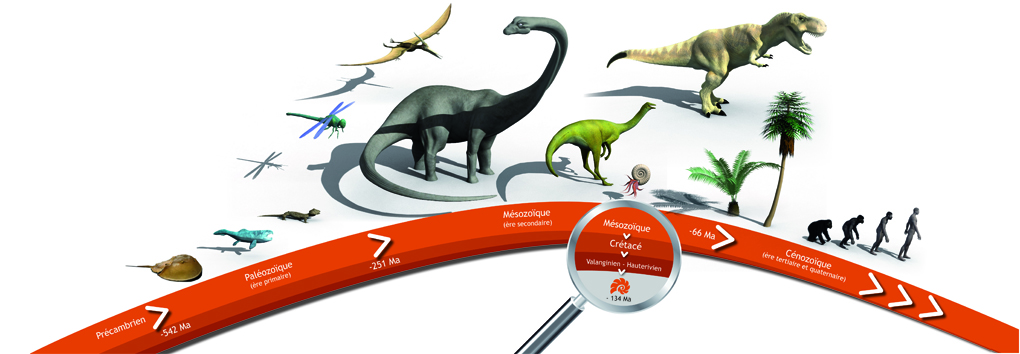
The cliff in front of you dates back to the Cretaceous period in the Mesozoic era.
Precambrian: the most ancient time in Earth’s history: from its formation 4.5 billion years ago up to 542 Ma (million years ago). The life forms were mostly unicellular bacteria.
Paleozoic era (542 to 251 Ma): appearance of the first marine animals and then vertebrates. The continents began to be conquered first by plant life and then by animals.
Mesozoic era, (251 to 66 Ma): arrival of big reptiles and dinosaurs. The first mammals, flowering plants and birds also evolved.
Cenozoic era (66 Ma to today): proliferation and diversification of mammals (including Man!) and flowering plants. So in which period were the rocks we see here formed?
The cliff in front of you dates back to the Mesozoic (Secondary) era and more precisely the Cretaceous period of this era.
Let’s try and pinpoint it on the geological timeline.
There are 4 major timelines in the history of the planet:
> The Precambrian era covers the most ancient time in Earth’s history: from the formation of Earth about 4.5 billion years ago up to 542 Ma (million years ago). Life forms were mostly unicellular bacteria. Soft-bodied marine animals with quite complex organisms appeared at the end of the Precambrian.
> It was during the Paleozoic era (542 to 251 Ma) that the first marine animals with a shell or carapace appeared, followed by the vertebrates. This was also the era when the continents were conquered first by plant life and then animals ventured onto dry land.
> The Mesozoic or “middle life” era, (251 to 66 Ma) is also called the Age of the Reptiles: dinosaurs ruled the Earth. The first mammals also evolved and flowering plants appeared. Birds gradually took to the skies and the seas were populated by numerous ammonites. This is where Serre de l’Ane is situated, more or less in the middle of this era.
> The Cenozoic or “new life” era (Tertiary and Quaternary periods: 66 Ma to today) is also known as the Age of the Mammals. Indeed mammals and flowering plants diversified and proliferated, and life on Earth began to look a little more like what we know today. The Quaternary is now no longer considered as an era, but as the third part of the Tertiary period. It was in this period that a new line of Primates appeared and developed: they would evolve into Man.

